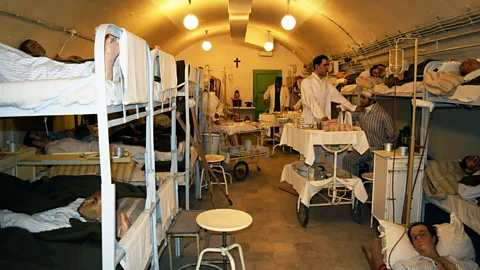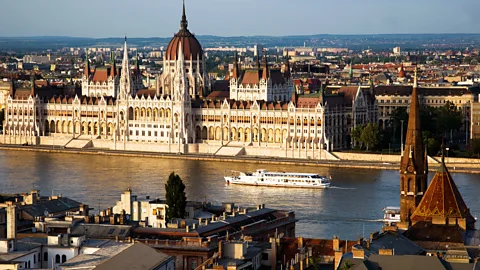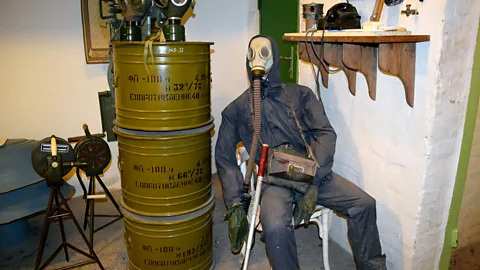Budapest’s secret underground hospital
 Sara Toth Stub
Sara Toth StubKnown as the ‘Hospital in the Rock’, this underground facility remained a government secret for decades.
In autumn 1956, as Soviet troops suppressed the Hungarian uprising against the country’s communist regime, three-year-old Erzsebet Seibriger and her family headed underground to one of Budapest’s many natural caves where they were safe from tanks, bombs and gunfire.
But their location – an underground hospital where Seibriger’s surgeon father treated both Hungarian revolutionaries and Soviet soldiers – would haunt them for years.
 Eye Ubiquitous/Getty
Eye Ubiquitous/GettyAfter Soviet troops crushed the rebellion, tens of thousands of Hungarians were imprisoned or executed for participating, including doctors who treated injured freedom fighters. Due to a heart condition, Seibriger’s father was not jailed – but he did lose his medical license.
“He was one of the lucky ones,” Seibriger recalled. “But there was a constant fear at home that maybe he would, eventually, be arrested.”
Even though the government declassified the hospital’s existence in 2002, and this year it will celebrate its 10th year as the Hospital in the Rock Nuclear Bunker Museum, the space remains frozen in time, full of mysteries and untold stories. The Seibrigers’ story is one of only hundreds that have emerged since the museum opened.
“Many Hungarians still don’t know about this place,” said Fruzsina Polacska, marketing coordinator for the museum.
Today, the beds in one ward are filled with lifelike wax figures of Hungarian, German and Russian soldiers to depict scenes from when the hospital was first used during World War II. Another room includes a figure of a young Dr Seibriger standing among beds of patients injured during the 1956 uprising.
 Globetrotter19/CC
Globetrotter19/CCThe natural caves under Budapest’s Buda district on the western bank of the Danube River that runs through the middle of the city have had many purposes throughout history, from storing food to housing prisoners to hosting a harem when Ottoman forces ruled the city in the 16th Century. When World War II broke out, a municipal air-raid siren control room was built in one of the caves, and as the fighting intensified, city officials drew up plans to build emergency medical facilities here.
The Hospital in the Rock, which opened in 1944, was connected by passageway to the nearby, above-ground St John’s hospital, which could provide fresh food and supplies. “It was very modern for its time,” Polacska said. “They had everything they needed.”
Or, so it seemed.
As World War II persisted and the Russians continued to hold Budapest under siege, the Hospital in the Rock became the only place in the heavily-bombed city where people could get an x-ray or an operation. The facility quickly became overwhelmed, housing up to 700 patients ‒ nearly 10 times its capacity. Treated patients did not want to leave for fear of the war outside, and often family members and friends of those injured stayed as well, using the hospital as a shelter.
“Every inch was occupied,” Countess Ilona Szechenyi, a volunteer at the hospital with the Red Cross at this time, told the museum’s historian in a 2008 interview. She recalled sleeping on a stretcher that became free when a patient died. “The drying blood pouring on me and its overwhelming odour was not really a pleasant experience,” she said.
 Sara Toth Stub
Sara Toth StubWith so many patients and inadequate supplies, infection was rampant, and each day, bodies were taken outside and quickly given temporary burial in bomb craters. Bandages were taken off dead bodies and used to treat new patients.
“The hygiene was at its worst. It was unbearably stinky all over the place.” recalled Gyula Steinert, a volunteer doctor whose story was recorded in a book written by his daughter, Agota Steinert.
Eventually, damage from bombing disrupted the underground hospital’s water supply, and destroyed the tunnel connecting it to St John’s.
When the siege finally ended in February 1945, with Hungary coming under the control of the Soviet Union, many of the doctors and nurses who worked at the hospital fled the country to avoid living under Soviet rule, taking advantage of certificates of international protection they were issued by the Red Cross during the war. But Dr Seibriger chose to stay, returning to his home in the nearby Castle District.
When fighting broke out between the Hungarians and the Russians in 1956, Dr Seibriger again reported for duty at the hospital ‒ this time with his wife and two small children in tow.
 Sara Toth Stub
Sara Toth Stub“My memories are running around and playing hide and seek,” Seibriger said. “I remember people coming in on stretchers, but as a child that was interesting and fun to see. It was like a playground.”
After the uprising was crushed, Dr Seibriger was given another opportunity to leave the country, as many escaped through temporarily open borders.
“We left the house but my father turned back and said that he could not leave the country, because the hospital would need him anytime,” Seibriger recalled. “My mother did not want to go without him. So we stayed here.”
The revolution proved to be the last time the facility functioned as a hospital. As the Cold War and threats of nuclear attack intensified, the hospital was transformed into a nuclear bunker kept secret by the ruling Hungarian Communist Party. A water storage system was added that could hold a three-week reserve of clean water. The air supply system was outfitted with active carbon filters that would clean any contaminated air.
Much of this equipment still works today.
 Sara Toth Stub
Sara Toth StubThe role Dr Seibriger played at the hospital continued to affect his daughter long after the last patient was released. Not only was he without work for many years and living in fear of potential arrest, but he also banned her from participating in communist-related activities at school, such as May Day celebrations.
“This was hard for me as a teenager, to be the one doing something different,” she recalled.
Seibriger was also rejected several times from medical school despite her high grades. With all universities under control of the communist regime, she suspects these rejections were due to the activities of her father, who passed away in 1977.
It was only with the final falling of communism in Hungary in 1989 and the passing of time that Seibriger has come to appreciate how brave her father – the only doctor to serve at the hospital during both World War II and the Hungarian uprising – was.
Now a grandmother of six, Seibriger still lives in Budapest near the Hospital in the Rock. She returned to the facility for the first time since the uprising, when it opened as a museum in 2007. The tour guides back then didn’t realise that the hospital functioned in 1956, and only talked about its role during World War II. Since then, Seibriger has helped the staff piece together stories about the hospital’s role in the uprising, and has donated her father’s medical tools and official documents to the museum.
“This place is very important to me, and it’s a very important thing that it brings the history alive and closer to people today,” Seibriger said. “It’s authentic, and it shows how the people who worked here were risking their lives.”
“I realise now that I can’t complain about what he did,” she added. “My father was very brave, and I am very happy that I can tell his story, and my story.”
Join over three million BBC Travel fans by liking us on Facebook, or follow us on Twitter and Instagram.
If you liked this story, sign up for the weekly bbc.com features newsletter called "If You Only Read 6 Things This Week". A handpicked selection of stories from BBC Future, Earth, Culture, Capital and Travel, delivered to your inbox every Friday.
